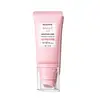What's inside
What's inside
 Key Ingredients
Key Ingredients

 Benefits
Benefits

 Concerns
Concerns

 Ingredients Side-by-side
Ingredients Side-by-side

Water
Skin ConditioningButylene Glycol
HumectantHomosalate
Skin ConditioningIsoamyl P-Methoxycinnamate
UV AbsorberMethylene Bis-Benzotriazolyl Tetramethylbutylphenol
UV FilterSilica
AbrasiveBis-Ethylhexyloxyphenol Methoxyphenyl Triazine
Skin ConditioningDiethylhexyl Butamido Triazone
UV AbsorberDibutyl Adipate
EmollientCaprylyl Methicone
Skin ConditioningNiacinamide
SmoothingButyloctyl Salicylate
Skin ConditioningDiethylamino Hydroxybenzoyl Hexyl Benzoate
UV FilterEthylhexyl Triazone
UV AbsorberCI 77891
Cosmetic ColorantAlpha-Arbutin
AntioxidantTranexamic Acid
AstringentTocopherol
AntioxidantDecyl Glucoside
CleansingPhenoxyethanol
PreservativeAcrylates/C10-30 Alkyl Acrylate Crosspolymer
Emulsion StabilisingPotassium Cetyl Phosphate
EmulsifyingTromethamine
BufferingChlorphenesin
AntimicrobialPEG-240/Hdi Copolymer Bis-Decyltetradeceth-20 Ether
StabilisingDisodium EDTA
Ethylhexylglycerin
Skin ConditioningPropylene Glycol
HumectantPhytic Acid
Xanthan Gum
EmulsifyingSodium Hydroxide
BufferingPotassium Laurate
EmulsifyingWater, Butylene Glycol, Homosalate, Isoamyl P-Methoxycinnamate, Methylene Bis-Benzotriazolyl Tetramethylbutylphenol, Silica, Bis-Ethylhexyloxyphenol Methoxyphenyl Triazine, Diethylhexyl Butamido Triazone, Dibutyl Adipate, Caprylyl Methicone, Niacinamide, Butyloctyl Salicylate, Diethylamino Hydroxybenzoyl Hexyl Benzoate, Ethylhexyl Triazone, CI 77891, Alpha-Arbutin, Tranexamic Acid, Tocopherol, Decyl Glucoside, Phenoxyethanol, Acrylates/C10-30 Alkyl Acrylate Crosspolymer, Potassium Cetyl Phosphate, Tromethamine, Chlorphenesin, PEG-240/Hdi Copolymer Bis-Decyltetradeceth-20 Ether, Disodium EDTA, Ethylhexylglycerin, Propylene Glycol, Phytic Acid, Xanthan Gum, Sodium Hydroxide, Potassium Laurate
Water
Skin ConditioningZinc Oxide
Cosmetic ColorantTitanium Dioxide
Cosmetic ColorantCyclopentasiloxane
EmollientPEG-10 Dimethicone
Skin ConditioningTriethoxycaprylylsilane
Silica
AbrasiveEthylhexyl Salicylate
UV AbsorberCetyl Ethylhexanoate
EmollientDimethicone
EmollientTrimethylsiloxysilicate
EmollientDipropylene Glycol
HumectantAcrylates Copolymer
Cetyl PEG/PPG-10/1 Dimethicone
EmulsifyingSodium Lactate
BufferingSodium Gluconate
Skin ConditioningPolyacrylate Crosspolymer-6
Emulsion StabilisingPhenoxyethanol
PreservativeEthylhexylglycerin
Skin ConditioningMica
Cosmetic ColorantButylene Glycol
HumectantCentella Asiatica Extract
CleansingPolygonum Cuspidatum Root Extract
AntioxidantScutellaria Baicalensis Root Extract
AstringentCamellia Sinensis Leaf Extract
AntimicrobialGlycyrrhiza Glabra Root Extract
BleachingChamomilla Recutita Flower Extract
MaskingRosmarinus Officinalis Leaf Extract
AntimicrobialDisodium EDTA
CI 77491
Cosmetic ColorantCI 77492
Cosmetic ColorantWater, Zinc Oxide, Titanium Dioxide, Cyclopentasiloxane, PEG-10 Dimethicone, Triethoxycaprylylsilane, Silica, Ethylhexyl Salicylate, Cetyl Ethylhexanoate, Dimethicone, Trimethylsiloxysilicate, Dipropylene Glycol, Acrylates Copolymer, Cetyl PEG/PPG-10/1 Dimethicone, Sodium Lactate, Sodium Gluconate, Polyacrylate Crosspolymer-6, Phenoxyethanol, Ethylhexylglycerin, Mica, Butylene Glycol, Centella Asiatica Extract, Polygonum Cuspidatum Root Extract, Scutellaria Baicalensis Root Extract, Camellia Sinensis Leaf Extract, Glycyrrhiza Glabra Root Extract, Chamomilla Recutita Flower Extract, Rosmarinus Officinalis Leaf Extract, Disodium EDTA, CI 77491, CI 77492
 Reviews
Reviews

Ingredients Explained
These ingredients are found in both products.
Ingredients higher up in an ingredient list are typically present in a larger amount.
Butylene Glycol (or BG) is used within cosmetic products for a few different reasons:
Overall, Butylene Glycol is a safe and well-rounded ingredient that works well with other ingredients.
Though this ingredient works well with most skin types, some people with sensitive skin may experience a reaction such as allergic rashes, closed comedones, or itchiness.
Learn more about Butylene GlycolDisodium EDTA plays a role in making products more stable by aiding other preservatives.
It is a chelating agent, meaning it neutralizes metal ions that may be found in a product.
Disodium EDTA is a salt of edetic acid and is found to be safe in cosmetic ingredients.
Learn more about Disodium EDTAEthylhexylglycerin (we can't pronounce this either) is commonly used as a preservative and skin softener. It is derived from glyceryl.
You might see Ethylhexylglycerin often paired with other preservatives such as phenoxyethanol. Ethylhexylglycerin has been found to increase the effectiveness of these other preservatives.
Phenoxyethanol is a preservative that has germicide, antimicrobial, and aromatic properties. Studies show that phenoxyethanol can prevent microbial growth. By itself, it has a scent that is similar to that of a rose.
It's often used in formulations along with Caprylyl Glycol to preserve the shelf life of products.
Silica, also known as silicon dioxide, is a naturally occurring mineral. It is used as a fine, spherical, and porous powder in cosmetics.
Though it has exfoliant properties, the function of silica varies depending on the product.
The unique structure of silica enhances the spreadability and adds smoothness, making it a great texture enhancer.
It is also used as an active carrier, emulsifier, and mattifier due to its ability to absorb excess oil.
In some products, tiny microneedles called spicules are made from silica or hydrolyzed sponge. When you rub them in, they lightly polish away dead skin layers and enhance the penetration of active ingredients.
Learn more about SilicaWater. It's the most common cosmetic ingredient of all. You'll usually see it at the top of ingredient lists, meaning that it makes up the largest part of the product.
So why is it so popular? Water most often acts as a solvent - this means that it helps dissolve other ingredients into the formulation.
You'll also recognize water as that liquid we all need to stay alive. If you see this, drink a glass of water. Stay hydrated!
Learn more about Water